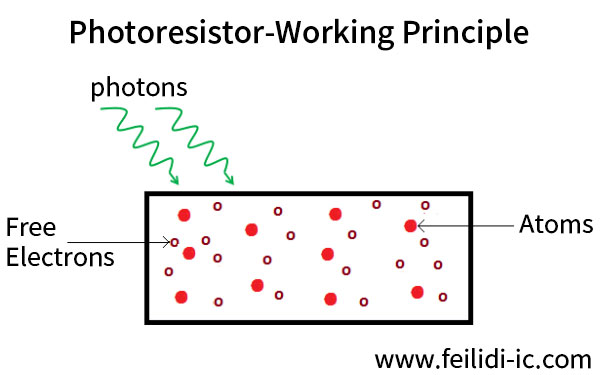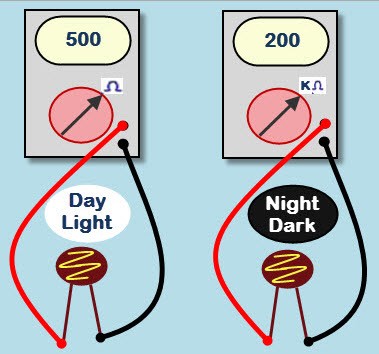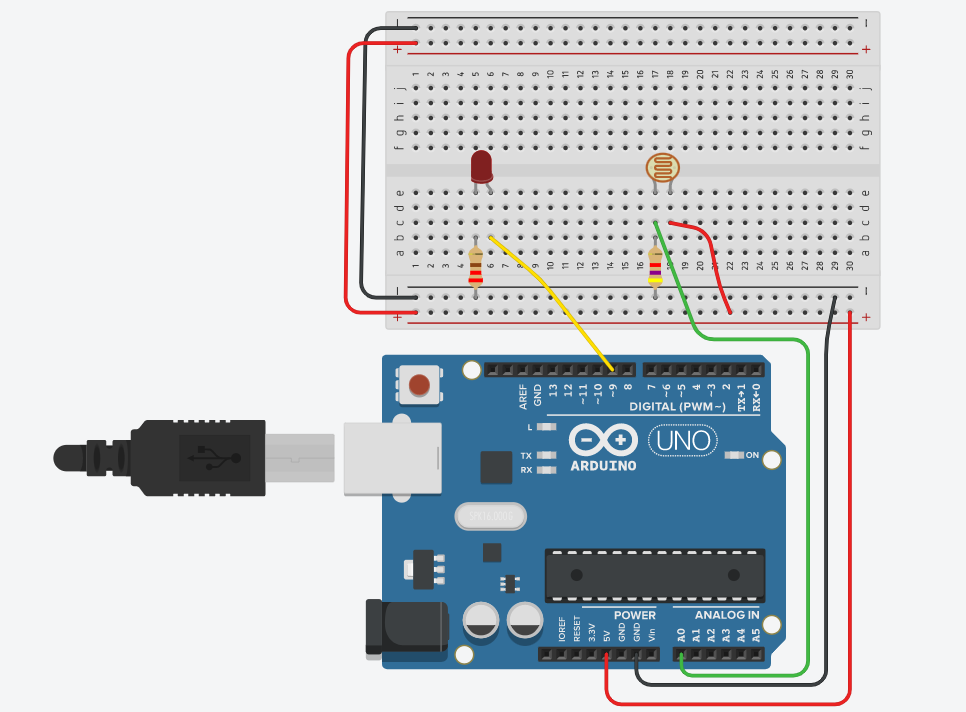Photoresistor Basics: Types, Principles and Applications
I Introduction
There are three types of photoresistor: ultraviolet photoresistors, infrared photoresistors, visible light photoresistors. Dimming circuit and light switch are the two applications of the photoresistor.

Catalog
II What is a Photoresistor?
2.1 Definition
A photoresistor (also known as a Photocell, or light-dependent resistor, LDR, or photo-conductive cell) is a passive component that decreases resistance with respect to receiving luminosity (light) on the component's sensitive surface.
2.2 Symbol
In order to represent a Photoresistor in a circuit diagram, the symbol chosen was that would indicate it to be a light dependent device along with the fact that it is a resistor.
While mostly the symbol used is shown in figure (two arrows pointing to a resistor), some prefer to encase the resistor in a circle like that shown in figure

2.3 Composition
Structurally the photoresistor is a light sensitive resistor that has a horizontal body that is exposed to light. The active semiconductor region is normally deposited onto a semi-insulating substrate and the active region is normally lightly doped.

III How Does the Photoresistor Work?
3.1 The Working Principle of Photoresistors
Working principle of a Photoresistor
In order to understand the working principle of a Photoresistor, let’s brush up a little about the valence electrons and the free electrons.
As we know valence electrons are those found in the outermost shell of an atom. Hence, these are loosely attached to the nucleus of the atom. This means that only some small amount of energy is needed to pull it out from the outer orbit.
Free electrons on the other hand are those which are not attached to the nucleus and hence free to move when an external energy like an electric field is applied. Thus when some energy makes the valence electron pull out from the outer orbit, it acts as a free electron; ready to move whenever an electric field is applied. The light energy is used to make valence electron a free electron.
This very basic principle is used in the Photoresistor. The light that falls on a photoconductive material is absorbed by it which in turn makes lots of free electrons from the valence electrons.
The figure below shows a pictorial representation of the same:

As the light energy falling on the photoconductive material increases, number of valence electrons that gain energy and leave the bonding with the nucleus increases. This leads to a large number of valence electrons jump to the conduction band, ready to move with an application of any external force like an electric field.
3.2 Internal Photoelectric Effect
The creation of free electrons within a solid by the absorption of a sufficient amount of photons. The effect produces an increase in the conductivity of the solid.
The internal photoelectric effect does not produce photoelectrons which are observable outside the material, but only excites electrons to higher levels, namely from the valence band to the conduction band in a semiconductor material. A consequence of that is that a photocurrent is usually detected in a reverse-biased p–n junction or p–i–n junction.
The internal photoelectric effect is exploited in various types of semiconductor photodetectors, namely in photodiodes and phototransistors. Its precondition is that the photon energy is larger than the band gap energy of the material in the active region. While the bandgap energy of typical dielectrics like fused silica or other optical glasses is substantially too large, and also the carrier lifetime would be too short, various semiconductors exhibit a suitably small bandgap energy. For example, silicon-based detectors can work with wavelengths up to roughly 1.1 μm, although the responsivity often drops substantially above 1 μm. Materials with still lower bandgap energy allow photodetection at longer wavelengths – for example, indium gallium arsenide (InGaAs) up to ≈1.7 μm.
There are even materials for the detection of mid-infrared light, e.g. in infrared cameras. Their bandgap energy is so small that substantial thermal excitation occurs already at room temperature. To avoid that, such detectors need to be operated at substantially lower temperatures, e.g. using a Stirling cooler.
IV Photoresistor Application Circuit Diagram


A light sensor circuit activates when light is detected by the circuit. It is a simple circuit including a photoresistor followed by a transistor. When light strikes the surface of the photoresistor, light energy is converted into an electrical signal and thus, the circuit is operational.
Here, the light sensor is made with two different circuits,This is the simplest circuit of light sensors. This circuit involves just a photoresistor that, when photons of light hit the base, produces an electrical signal. The signal generated triggers the 2N2222 transistor. Thus, lighting the LED.
V Types of Photoresistor
5.1 Classification by Materials
Polycrystalline and single crystal photoresistors can also be divided into cadmium sulfide (CdS), cadmium selenide (CdSe), lead sulfide (PbS), lead selenide (PbSe), indium antimonide (InSb) photoresistors, etc.

5.2 Classification by Spectral Characteristics
(1) Ultraviolet photoresistor: sensitive to ultraviolet rays, including cadmium sulfide, cadmium selenide photoresistors, etc., used to detect ultraviolet rays.
(2) Infrared photoresistors: mainly lead sulfide, lead telluride, and lead selenide. Photoresistors such as indium antimonide are widely used in missile guidance, astronomical detection, non-contact measurement, human disease detection, infrared spectroscopy, infrared communication and other national defense, scientific research, and industrial and agricultural production.
(3) Visible light photoresistors: including selenium, cadmium sulfide, cadmium selenide, cadmium telluride, gallium arsenide, silicon, germanium, zinc sulfide photoresistors, etc. Mainly used in various photoelectric control systems, such as photoelectric automatic switch portals, automatic turning on and off of navigation lights, street lights and other lighting systems, automatic water supply and automatic water stop devices, automatic protection devices on machinery and "position detectors" Thickness detectors for thin parts, automatic exposure devices for cameras, photoelectric counters, smoke alarms, photoelectric tracking systems, etc.
VI The Main Parameters and Basic Characteristics of the Photoresistor
6.1 The Main Parameters of the Photoresistor
1) Bright resistance (kΩ): refers to the resistance value of the photoresistor when exposed to light.
2) Dark resistance (MΩ): refers to the resistance value of the photoresistor when there is no light exposure (dark environment).
3) Maximum working voltage (V): refers to the highest voltage the photoresistor is allowed to withstand under the rated power
4) Bright current: refers to the current that the photoresistor passes when it is irradiated by light under the specified applied voltage.
5) Dark current (mA): refers to the current that the photoresistor passes under the specified applied voltage when there is no light.
6) Time constant (s): refers to the time required for the photoresistor to start from the light jump to stabilize 63% of the bright current.
7) Resistance temperature coefficient: refers to the relative change of the resistance value of the photoresistor when the ambient temperature changes by 1°C.
8) Sensitivity: refers to the relative change of the resistance value of the photoresistor with and without light irradiation.
6.2 Basic Characteristics
(1) Dark resistance and bright resistance
· The stable resistance value measured by the photoresistor under room temperature and total darkness is called dark resistance. The current flowing at this time is called dark current. For example, MG41-21 type photoresistor dark resistance is greater than or equal to 0.1M.
· The stable resistance value measured by the photoresistor at room temperature and under certain lighting conditions is called bright resistance. The current flowing at this time is called the bright current. The bright resistance of MG41-21 type photoresistor is less than or equal to 1k.
The difference between bright current and dark current is called photocurrent.
Obviously, the larger the dark resistance of the photoresistor, the better, and the smaller the bright resistance, the better, that is, the dark current should be small and the bright current should be large, so the sensitivity of the photoresistor is high.
(2) Volt-ampere characteristics
Under a certain illuminance, the relationship between the voltage applied across the photoresistor and the current flowing through the photoresistor is called the volt-ampere characteristic.
The volt-ampere characteristic of the photoresistor is approximately a straight line, and there is no saturation phenomenon. Due to the limitation of power dissipation, the voltage across the photoresistor cannot exceed the maximum operating voltage during use. The dotted line in the figure is the allowable power consumption curve, from which the normal operating voltage of the photoresistor can be determined.
(3) Photoelectric characteristics
The relationship between the photocurrent of the photoresistor and the illuminance is called the photoelectric characteristic. The photoelectric characteristics of the photoresistor are nonlinear. Therefore, it is not suitable as a detection element, which is one of the shortcomings of the photoresistor. In automatic control, it is often used as a switching photoelectric sensor.

VII Arduino Photoresistor Tutorial
7.1 LED Control with Photoresistor and Arduino
Explore the sample circuit embedded here in the workplane by clicking Start Simulation and clicking on the photoresistor (brown oval with squiggly line down the middle), then drag the brightness slider to adjust the simulated light input.

Code Explanation:
We declare the pins the we are going to use for the photoresistor and led diode in lines 1 and 2. At line 3, 4, 5, 6 we need to declare the function of the components that we have connected if is an input or an output . Line 8 is the starting of the cycle that is going to perform while Arduino is powered on. Line 10 is used for reading analog values from photoresistor and storing the values to a variable called “int readAnalogValue”.
Line 11 is a function that stores the value analog read divided by 4 to a new variable called “int tmp”. Line 13 is the function that makes the Led lighting to change and line 14 is the delay that Arduino performs between different values.
VIII How to Use Multimeter to Detect the Quality of Photoresistor?
When testing, turn the multimeter to resistance 1 K, and cover the light-transmitting window of the photoresistor with a black piece of paper. At this time, the pointer of the multimeter basically remains unchanged, and the resistance value is close to infinity. The larger the value, the better the performance of the photoresistor. the better. If this value is very small or close to zero, it means that the photoresistor has been burned out and cannot be used further. Light detection. Aim a light source at the light-transmitting window of the photoresistor. At this time, the pointer of the multimeter should swing by a large margin, and the resistance value will be significantly reduced.




 Need Help?
Need Help?







